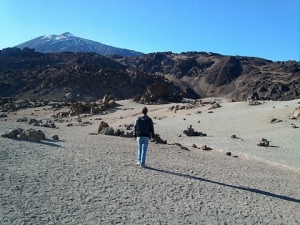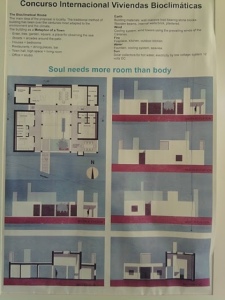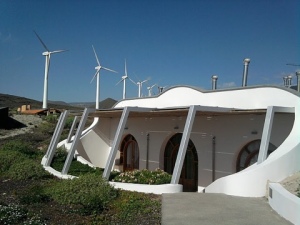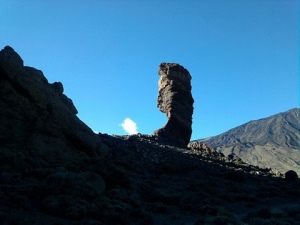Notes from the volcano: the current state of renewable energy in Spain
January 16, 2011 1 Comment
Last December, Spain clearly established itself as the world leader in renewable energy by exporting electricity to its neighbour France for the first time. Heavy rain and strong winds during 2010 have boosted renewables – principally hydro, wind and solar power – that managed to meet 35% of Spanish demand last year.
 I spent the last week in Tenerife, the largest and most populous of the seven Canary Islands, a Spanish archipelago located just off the northwest coast of mainland Africa. My main objective was to discover Mount Teide, the highest elevation of Spain, 3718 m., a World Heritage Site that is the third largest volcano in the world from its base. I also wanted to check on the development of local projects for renewable energy.
I spent the last week in Tenerife, the largest and most populous of the seven Canary Islands, a Spanish archipelago located just off the northwest coast of mainland Africa. My main objective was to discover Mount Teide, the highest elevation of Spain, 3718 m., a World Heritage Site that is the third largest volcano in the world from its base. I also wanted to check on the development of local projects for renewable energy.
“How many architects does it take to save the world?” asks Colin Kirby a British journalist who lives in Tenerife. ” Well, he says, you can start by inviting 397 from 38 countries, hand-pick the best 25 and let them loose on a 14 year project.” 
That’s exactly what the ITER, the Institute of Technology and Renewable Energies, founded by the Tenerife Island Government in 1990 to promote applied research in the field of renewable energy, did. The project, that started in 1995, culminated last year in the launch of 25 innovative bioclimatic homes.
 The houses, heralded as the “green architecture of the future”, generate zero carbon emissions, are self-sufficient and do not depend on external energy sources. They are also Tenerife’s commitment to responsible tourism, a project that aims to encourage sustainable practices throughout the tourism industry and interaction with the local culture. The houses, but also the visitors centre, that has a selection of rooms and a spacious auditorium for training, talks and conferences, can be rented.
The houses, heralded as the “green architecture of the future”, generate zero carbon emissions, are self-sufficient and do not depend on external energy sources. They are also Tenerife’s commitment to responsible tourism, a project that aims to encourage sustainable practices throughout the tourism industry and interaction with the local culture. The houses, but also the visitors centre, that has a selection of rooms and a spacious auditorium for training, talks and conferences, can be rented.
 Last week, I had the opportunity to visit a dozen of these 25 houses. They are simply amazing. Facing the Atlantic Ocean in a natural setting worthy of a visit, with some of the most beautiful and least known beaches of the island, the site is composed by a total of 25 detached single-family houses in a plot of land of nearly 50,000 m2 facing south (first of a series of passive solutions to improve energy efficiency), designed by architects from around the world. The price for these houses rental goes from 200 to 300 Euros per night. Each house can accommodate up to 6 people.
Last week, I had the opportunity to visit a dozen of these 25 houses. They are simply amazing. Facing the Atlantic Ocean in a natural setting worthy of a visit, with some of the most beautiful and least known beaches of the island, the site is composed by a total of 25 detached single-family houses in a plot of land of nearly 50,000 m2 facing south (first of a series of passive solutions to improve energy efficiency), designed by architects from around the world. The price for these houses rental goes from 200 to 300 Euros per night. Each house can accommodate up to 6 people.
ITER also has three wind farms in operation, testing grounds for renewable technologies and a desalination plant among other facilities.

The Institute has a major role to play, locally, but also at the global level to promote renewables. Locally, the island of Tenerife, with a permanent population of just over one million, that can increase up to 1.5 million during peak tourist season, is relying mostly on imported diesel, resulting in very high-priced electricity, to meet local demand, in excess of 800 MW on peak power generation, with a significant carbon signature.
At a more global level, the result of the ITER long-term project is a model of residential complex that can be exported and reproduced anywhere in the world.
 Tenerife is not short of energy-related projects. Research is underway to see whether heat from Tenerife’s active volcano can be harnessed as a new renewable energy source. The study is being carried out by Australia-based Petratherm on behalf of ITER. It is aimed at displacing and/or avoiding the island’s reliance on imported fuel sources while concurrently reducing the island’s carbon footprint.
Tenerife is not short of energy-related projects. Research is underway to see whether heat from Tenerife’s active volcano can be harnessed as a new renewable energy source. The study is being carried out by Australia-based Petratherm on behalf of ITER. It is aimed at displacing and/or avoiding the island’s reliance on imported fuel sources while concurrently reducing the island’s carbon footprint.
According to a recent update by the Australian company, its local arm, Petratherm España, in conjunction with its 50% exploration partner Enel Green Power, has finalized the selection of a highly prospective geothermal target on the active volcanic island of Tenerife. Petratherm España is now undergoing the drilling approval process in preparation for a planned geothermal test scheduled for the 2nd quarter of 2011.
A local resident who knows the project well says that he “personally would rather see the money spent on research into bio-diesel fuel harvesting using algae farming.” Tenerife, he says, “would be an ideal place to farm algae due to the amount of sunshine we have here”. He explains that Algae can grow prolifically and double it’s volume in 24 hours under the right conditions. According to him, Algae also absorbs greenhouse gases including carbon dioxide so there would be a trade-off here with carbon emissions from the continued use of fossil fuels. Fossil fuels will always be necessary, the problem is that they are becoming depleted and Algae farming could be a great solution for Tenerife. Algae farming can produce bio-diesel fuels and ethanol very cheaply with some very positive ecological benefits.
 He concludes that “this sort of technology is already being used in Mexico with some great results, a lot of the research has already been done so it would not be costly to investigate this option.”
He concludes that “this sort of technology is already being used in Mexico with some great results, a lot of the research has already been done so it would not be costly to investigate this option.”
Renewables are currently at the center of public and media attention in Spain, not only for the fact that it started selling energy to France for the fist time but also because of the political debate around them.
Javier García Breva, a top executive at Arnaiz Consulting, former MP and President of the Fondation for Renewables, said recently to The Guardian, about the performance of Spain in renewables that “even five years ago no one would have believed these figures were possible. No one expected renewables to grow so fast. They have unlimited potential.”
However, both the Spanish Government and the opposition alike don’t seem to share this vision of the future. The former has recently introduced a highly criticized series of measures that limit the, generous, subsidies to the photovoltaic (PV) industry, while the latter has joined the chorus of those who say the world is betting on other technologies while “we’re running it alone with renewables.”
The Government’s Royal Decree 14/2010, the law that proposes to retroactively limit the number of production hours that are eligible to receive the government’s feed-in tariff, has probably a lot to do with internal and external pressures coming from the fossil fuel lobbies and with the drastic cutbacks imposed by the current economic turmoil.
The opposition’s attitude seems to be the consequence of a narrow-minded political strategy due to the upcoming local, regional and general elections.
Finally, the greening of the Spanish grid, unfortunately, has not benefited the consumer, with prices likely to rise by 9% in 2011. The government sets electricity prices which have no direct correlation with production costs. This policy doesn’t help as the debate about the country’s strategical choices is biased by political considerations. More transparency, regarding the cost and benefits of each source of energy, is urgently needed.
